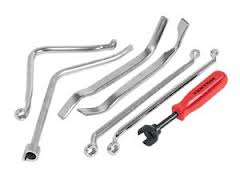Replacing Brake Shoes
There are several different configurations of drum brakes, but they all work similarly. The wheel cylinder forces the shoes against the inside of the brake drum and the brakes are activated. When you release the pressure in the wheel cylinder, the return springs pull the shoes away from the inside of the drum so that the brakes don’t continue to make contact. When replacing brake shoes, these return springs probably cause the most problems. I can’t stress enough how having the correct tools for this can save your bacon. So before you get into a rear brake job, I suggest you pick up a set of tools for servicing rear shoes. Trust me; you’ll thank me later. They really aren’t that expensive and I know you like tools. Why else are you reading this?
Click here for the link to Brake Tools.
Aside from the right tools, you’ll need the right lubricants. In this case, anti-seize is your friend. This is my preferred lubricant for the bosses on the backing plate where the shoes ride.
Speaking of this backing plate, inspect it carefully when doing your shoe replacement. You will see groves in these bosses, but sometimes they get too deep or wear right through the backing plate. If this happens, you have two options: Replace the backing plate, or weld them back up and grind them down. Either way works; just don’t ignore it.
One thing you might notice if you have a problem like this is a pop from the rear brakes during application or backing up. This pop is caused by the brake shoes hanging up in these groves. Lubricate or repair these bosses and the noise should go away.
In addition to the backing plate, you also need to get the brake adjustment correct for best results. Whenever you install brake shoes, you need to reset the self adjuster so that your shoes make good contact with the inside of the drum again.

This process can take some time and practice, but if you do it right, you’ll have a brake pedal that feels as solid as a rock. When you have a vehicle with drum brakes, your brake pedal feel is dictated by this adjustment. Sometimes people come to me thinking they need brakes, and all I need to do is clean and adjust the rear brakes and they think I’ve replaced the entire brake system. Take the time when you’re done replacing the shoes to adjust the brakes properly. Not only will your brakes feel better, but your parking brake will work better too. Don’t go too tight, however; if you do, the brakes might drag and overheat, causing other problems. It takes a bit of practice to get a brake adjustment right. Better to go too loose than too tight.
If you’re replacing your brake shoes, you should also consider replacing the springs and hardware. These often come in a kit called a hardware kit, and are usually fairly inexpensive. Considering these springs help the brake shoes return after a brake application, it’s a good idea to replace them when doing drum brake service. Just ask for a hardware kit when purchasing your brake shoes.
Here are a few videos about replacing brake shoes that you might find helpful.
https://www.youtube.com/watch?v=MCpCkun2qxA
https://www.youtube.com/watch?v=sTpKpkxJjLQ
https://www.youtube.com/watch?v=5yYGtK96L1Q
Video Title: Replacing Brake Shoes – Solving Brake Problems – EricTheCarGuy Video Description: In this Article we show what to look for when Replacing Brake Shoes. Thumbnail: http://www.ericthecarguy.com/images/faq_buttons/Large_FAQ_Images/Brakes-icon-1200.jpg
 Our Address
Our Address



